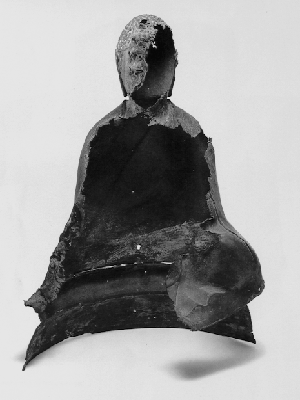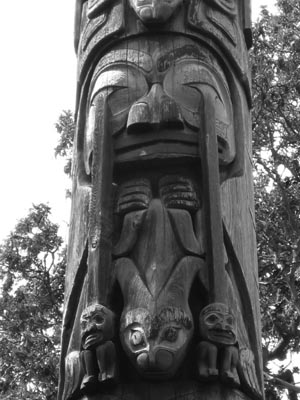
Scorched Buddha found at Hiroshima

Frog Woman
Last week, I looked up from my rather louche nightly routine of eating spumoni while watching the simulated autopsies of Crime Scene Investigation and suddenly I realized that it was all over. Summer that is . . .
The end of summer has always been a poignant time for me. Like most children, I was anxious about the coming school year, wishing I could somehow stop time and savour the vanishing season for just a little longer. During these last warm days, the tangibility of summer’s once endless possibility seemed to slip through my fingers like warm sand, dissolving into memory where it fell, leaving my empty hands to grasp onto what? Inevitability?
But a shimmering blue sky can emanate its own darkness. It was from just such a sky, on the morning of August 6th 1945, that Little Boy fell, unstoppably, towards his target.
That morning, Claude Robert Eatherley gave the fateful weather report from aboard his B-29 Superfortress:
“Hiroshima without any clouds, very good weather, excellent visibility,”
which was the go-ahead for Little Boy’s evil to be unleashed. Driven mad by his culpability in what happened next, he spent the next three decades in a mental hospital, endlessly repeating weather reports, until finally he died.
Another clear blue morning, this time early in September. I am in a canoe, lazily paddling down the Mississippi, as it winds through the black earth country of Wisconsin’s Driftless. Along the banks, the leaves of willows and poplars scintillate in the morning sun, their green lushness having grown a bit waxy from the summer’s long heat. Scattered golden leaves are already quivering on the thorny branches of the honey locusts, the first tree to change colour in response to the newly cool air of the night. Here and there clots of turtles bask on half submerged logs, some stacked two and three deep, like shiny black bowls, upturned and left to dry by the kitchen sink. Craning their wrinkled necks and stretching out their webbed feet, they strain to expose as much of their cold reptilian skin as possible to the precious rays of the late summer sun. For they know that it is waning. As they see my canoe approach, they plop into the water and disappear, waiting in the murk for me to go away. Somewhere in the distant reed beds, a bittern makes its crazy pumping sound, like it has since the beginning of rivers.
That evening I return, exhausted and elated, falling into a deep and primal sleep. Just after sunrise, the silence is broken by the ringing of the telephone, pregnant with the news of what had just happened in New York. September 11th, 2001. I awake to find that everything has changed. A fault line in history has quaked and the world lurched forward into an unlooked for new singularity, born in flames like a malevolent phoenix, amid the perfect blueness of a Tuesday morning sky.
As a boy growing up in Toronto, in what my nostalgia has coloured into a kinder, gentler age, the end of August was when the first cool nights happened— so soothing after interminable weeks of snatching sleep from sweat-soaked sheets in the stale, furnace-like air of our little bedrooms. We called this magic time “Exhibition Weather” after the Canadian National Exhibition which, like a great, dilapidated old prostitute, came out of hiding at the end of every summer to expose her sagging, perfumed flesh to the last of the season’s warmth. Even though the “Ex” meant that the idleness of summer was almost over for us, we looked forward to it intensely. Going there was both cathartic and an affirmation of the passage of time. So beguiled were we by the fair’s blend of luridness and folksiness, that if we could, we went back two or three times, before it all got taken down at the end of Labour Day. It was the climax of summer and we never felt so free. . .
I remember The Ex’s sprawling grounds as a phantasmagorical mishmash of architecture. I loved the soot-stained friezes of the art deco Horse Palace, the shocked, streamlined horse heads, fossilized in mid-rampage, staring out forever at their mechanical replacements, howling along the Gardiner Expressway.
I loved the High Modernist suavity of the Bulova tower— its glassy Lego blockiness exuding a minimalist cool. The graceful, gravity-defying parabola at the Dufferin Gate, soared like the frozen trajectory of a bouncing super ball, up beyond the impacted neo-English brickscapes of the surrounding neighbourhoods and out into the Space Age.
After passing through one of the gates, my school chums would immediately head for the seething throngs of the Midway, eager to slam around the gut-wrenching turns of the Wild Mouse and then be spin-dried by the great Tilt-a-Whirl, whose bottom would drop out half way through the ride, leaving its shrieking human cargo plastered against the sidewalls held up by mere centrifugal force. Their boastful reminiscences of projectile vomiting became a staple of our school yard banter for the rest of the year. Suspicious of the machinery, I shunned these rides, especially knowing that the boozy carny mechanics entrusted with maintaining them were lurking in the shadows underneath, leering at the torsos of the school girls filing past their greasy faces. I once got lured into a sweaty Freak Show tent, its fleshy banners having promised me untold marvels. All I got for my buck was a glimpse of a sad and excemacious Lizard Boy and someone (or something), purporting to be a headless woman, propped up in front of a lurid, orange mural of a car, smashed up beside a lonely desert highway.
Inevitably though, I would take refuge from the din and head for the floral coolness of the Horticultural Building’s Victorian crystal palace domes. Of course this did make me the object of some derision. I was the only one in our little group who would openly confess to loving such bric-a-brac wonders as a set of gigantic French poodles, looking as if they had just walked in from planet Venus, made entirely of orange and yellow chrysanthemum blossoms— or a demented floral clock, a kind of homage to the beauty of xeriscaping, painstakingly constructed from hundreds of tiny pots of cacti. But my credibility returned somewhat, when I came home one time, having found the coolest Exhibition souvenir ever—a live Venus Fly Trap, growing in a transparent plastic cup. The endless hours we spent feeding it bits of meat that fall, earned me a respite from taunting, at least for a while.

Food Building (built 1954)
One thing we could agree on though, was that we all loved the Food Building. We would float deliriously through its great halls, like foraging whales, inhaling countless free samples of convenience foods until we were gorged to the bursting. I often detoured to admire the enormous butter sculptures, which in various years included a life-sized replica of the Beatles and once, a complete diorama of Neil Armstrong standing beside his lunar module. Quickly, I would rejoin my friends so I could stuff myself with even more free food. On the long ride home we would collapse onto the subway seats, pleasantly hallucinating from the amount of advanced chemistry we had just eaten, all thoughts of school happily expunged from our minds.
Back in those days, I never thought much of the future. There would always be another Ex, and fall would always follow summer in a predictable cadence of weather. But now I’m not so sure.
Three and a half decades later and I am living on the Pacific coast. This summer was kind of a low-key affair here and the first cool rains of autumn have already started. Yet just a few weeks ago, scientists confirmed that human-induced global warming has reached a tipping point, effectively saying that we have passed the point beyond which the consequences of our actions on the earth’s climate can be readily reversed. Shortly after this announcement, nearly the entire city of New Orleans is obliterated by a massive hurricane, caused by excess heat in our atmosphere.
On damp evenings, a little tree frog climbs into my bathroom window, as if to wish me good night. In Haida and Tlingit culture, Frog Woman, is one of the oldest and most powerful deities, an embodiment of nature and a repository for our collective memory of natural disaster. Though the frog seems frail and defenceless, her wrath, when unleashed, knows no bounds. But this only happens when we cause her the deepest of grief. In a little park in downtown Victoria, Frog Woman’s long wooden tears drip down from an old totem pole. In her arms, she holds the body of her dead son who has been thrown into a campfire by a callous young chief. She scorches the earth in her vengeance, killing everyone except for two women, who go on to become the ancestors of all subsequent generations. It is said that as the Frog Woman’s fire approached the people’ villages, they offered up their prayers, begging her for forgiveness. But it was too late. Her anger once released could no longer be abated. Time could just not be turned back.


